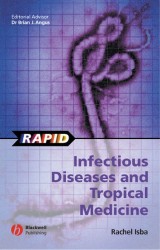Details

Rapid Infectious Diseases and Tropical Medicine
Rapid 1. Aufl.
|
34,99 € |
|
| Verlag: | Wiley-Blackwell |
| Format: | |
| Veröffentl.: | 05.02.2009 |
| ISBN/EAN: | 9781405140669 |
| Sprache: | englisch |
| Anzahl Seiten: | 180 |
DRM-geschütztes eBook, Sie benötigen z.B. Adobe Digital Editions und eine Adobe ID zum Lesen.
Beschreibungen
<i>Rapid Infectious Diseases</i> is the fourth book to appear in the <i>Rapid</i> series. Each book is designed for short revision covering key facts in a simple and memorable fashion, using well-thought out mnemonics to aid recall <br /> <p>This new text provides students in the run-up to exams with a comprehensive review of possible causes for symptoms and conditions as well as the key facts of around 100 diseases, following the <i>Rapid</i> mnemonic. There will also be an appendix giving details of immunisations as well as a list of Further Reading and useful web sites.<br /> </p> <p>Clinical students working on Emergency Medicine and General Practice attachments will find this book extremely useful. It may also interest those planning electives abroad. Junior doctors and GPs will find this a handy resource for quick access to information on the symptoms and diseases they may encounter in the clinical setting.</p>
Foreword. <p>List of Abbreviations.</p> <p>Rapid Series Mnemonic.</p> <p><b>Part 1: Signs & Symptoms</b>.</p> <p>Fever.</p> <p>Sepsis.</p> <p>Cardiovascular.</p> <p>Upper Respiratory Tract / ENT.</p> <p>Lower Respiratory Tract.</p> <p>Gastrointestinal.</p> <p>Hepatitis.</p> <p>Urinary Tract infection.</p> <p>Genitourinary.</p> <p>Central Nervous System.</p> <p>Eyes.</p> <p>Skin and soft tissue infection.</p> <p>Bone and joint infetcion.</p> <p>Immunocompromised host.</p> <p><b>Part 2: Aetiological Agents.</b></p> <p>Viruses.</p> <p>Bacteria.</p> <p>Mycobacteria.</p> <p>Fungi.</p> <p>Protozoa.</p> <p>Helminths.</p> <p>Spirochetes.</p> <p>Other organisms.</p> <p>Higher organisms.</p> <p>Ectoparasites.</p> <p><b>Part 3: Diseases (A-Z).</b></p> <p>Notifiable diseases.</p> <p>Actinomycosis.</p> <p>Adenovirus.</p> <p>Alphaviruses.</p> <p>Amoebiasis.</p> <p>Anaerobes.</p> <p>Anthrax.</p> <p>Aspergillosis.</p> <p>Atypical mycobacteria.</p> <p>Babesiosis.</p> <p>Bacillus cereus.</p> <p>Bacterial vaginosis.</p> <p>Bartonellosis.</p> <p>Blastomycosis.</p> <p>Botulism.</p> <p>Brucellosis.</p> <p><i>Campylobacter jejuni</i>.</p> <p>Candidiasis.</p> <p><i>Capnocytophaga</i>.</p> <p>Chlamydiae.</p> <p>Chickenpox, shingles.</p> <p>Cholera.</p> <p>Coccidiomycosis.</p> <p>Common cold.</p> <p>Coxsackie & Echoviruses.</p> <p>Cryptococcosis.</p> <p><i>Cryptosporidium, Cyclospora, Isospora, Microspora.</i></p> <p>Dengue.</p> <p>Dermatophytes.</p> <p>Diphtheria.</p> <p>Ectoparasites.</p> <p>Ehrlichosis.</p> <p>Filiariasis, Dracunculiasis, Trichinosis.</p> <p>Gangrene.</p> <p>Giardia.</p> <p>Glandular fever.</p> <p>Gonorrhoea.</p> <p>Gram negative bacteria.</p> <p>Haemolytic uraemic syndrome (<i>E. coli</i> O157).</p> <p><i>Haemophilus</i> spp.</p> <p>Hantaviruses.</p> <p><i>Helicobacter pylori.</i></p> <p>Hepatitis A.</p> <p>Hepatitis B & D.</p> <p>Hepatitis C.</p> <p>Hepatitis E.</p> <p>Herpes viruses.</p> <p>Histoplasmosis.</p> <p>HIV 1 & 2.</p> <p>HTLV1 & 2.</p> <p>Influenza & Parainfluenza viruses.</p> <p>Japanese B encephalitis.</p> <p>Legionellosis.</p> <p>Leishmaniasis.</p> <p>Leprosy.</p> <p>Leptospirosis.</p> <p>Listeriosis.</p> <p>Lyme disease.</p> <p>Malaria.</p> <p>Measles.</p> <p>Meningococcus.</p> <p>Molluscum contagiosum.</p> <p>Mucormycosis.</p> <p>Mumps.</p> <p><i>Mycoplasma spp.</i></p> <p><i>Nocardia.</i></p> <p>Papillomavirus.</p> <p>Parvovirus B19.</p> <p><i>Pasteurella</i>.</p> <p>Plague.</p> <p><i>Pneumocystis carinii</i>.</p> <p>Polio.</p> <p>Polyoma viruses.</p> <p>Prions.</p> <p><i>Pseudomonas aeruginosa.</i></p> <p>Q fever.</p> <p>Rabies.</p> <p>Rat bite fevers.</p> <p>Respiratory syncitial virus.</p> <p>Roundworms.</p> <p>Rubella.</p> <p>Salmonellosis.</p> <p>Schistosomiasis.</p> <p>Scrub typhus.</p> <p>Shigellosis.</p> <p>Smallpox.</p> <p>Sporothrix.</p> <p>Spotted fevers.</p> <p><i>Staphylococcus spp.</i></p> <p><i>Streptococcus spp.</i></p> <p>Syphilis.</p> <p>Tapeworms.</p> <p>Tetanus.</p> <p>Tick borne encephalitis.</p> <p>Toxoplasmosis.</p> <p>Treponema.</p> <p>Trichomoniasis.</p> <p>Trypanosomiasis.</p> <p>Tuberculosis.</p> <p>Tuleraemia.</p> <p>Viral gastroenteritis.</p> <p>Viral haemorrhagic fevers.</p> <p>Visceral larva migrans.</p> <p>Whooping cough.</p> <p>Yellow fever.</p> <p>Yersiniosis.</p> <p>Appendix I: Immunisations and Malaria prophylaxis.</p> <p>Appendix II: Antibiotics (therapy and prophylaxis) and needlestick prophylaxis.</p> <p>Sources and Further Reading</p>
<b>Published Reviews of the First Edition</b><br /> <p>"This book is a brief and quick source for key features to common infectious diseases. It can be used for a brief overview, nothing more. It is easy to read and has somewhat helpful tables to assist with categorizing pathogens."<br /> </p> <p><i>MD, Creighton University Medical Center<br /> Doody's Book Reviews</i></p>
<p><b>Rachel Isba</b> is the author of <i>Rapid Infectious Diseases and Tropical Medicine</i>, published by Wiley.</p>
<b>This new pocket guide provides rapid facts for everyday use in clinical practice and is an ideal resource for exam preparation</b>.<br /> <p><i>Rapid Infectious Diseases & Tropical Medicine</i> is the fourth title in the new Rapid series and is the ideal companion for medical students and junior doctors working on a wide range of clinical attachments, as well as general practitioners and emergency medical staff treating patients in primary care situations. It provides quick access to information on the common infectious diseases, their signs, symptoms, and aetiological agents. Arranged in A-Z format, each disease is covered using the same headings - Definition, Aetiology, Associations/Risk Factors, Epidemiology, History, Examination, Pathology, Investigations, Management, Complications, and Prognosis. There are also further sections on immunisations, malaria prophylaxis and antibiotics.</p> <ul> <li>Key symptoms and signs of infectious diseases</li> <li>Information on aetiological agents</li> <li>A-Z organization of over 100 common infectious diseases</li> <li>Concise entries following the Rapid series mnemonic to aid revision and recall</li> <li>Provides additional information on immunisations, Malaria prophylaxis, and recommended antibiotics therapy</li> </ul> <br /> <p><i>Rapid Infectious Diseases & Tropical Medicine</i> is authored by Rachel Isba, a recent medical graduate from Oxford University. Dr Brian Angus, a senior clinician and Clinical Tutor in Medicine at Oxford University has provided support and advice as the Editorial Advisor.</p>
<b>Published Reviews of the First Edition</b><br /> <p>"This book is a brief and quick source for key features to common infectious diseases. It can be used for a brief overview, nothing more. It is easy to read and has somewhat helpful tables to assist with categorizing pathogens."<br /> </p> <p><i>MD, Creighton University Medical Center<br /> Doody's Book Reviews</i></p>


















